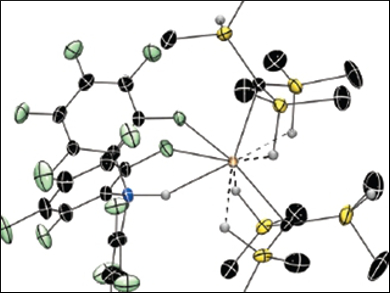Aaron Sadow and colleagues, Iowa State University, Ames, USA, have developed new organocerium compounds for catalytic hydrosilylation chemistry. Complexes containing cerium–carbon σ-bonds have properties such as high thermal sensitivity, highly polar bonds, and high reactivity toward oxygen-containing species, which makes the synthesis of homoleptic organocerium compounds challenging.
The ligand tris(dimethylsilyl)methyl can be easily transmetalated with cerium triiodide to give the isolable Ce{C(SiHMe2)3}3. This species reacts with the Lewis acid B(C6F5)3 by β-H abstraction to give the zwitterionic hydridoborato bis(alkyl)cerium species Ce{C(SiHMe2)3}2HB(C6F5)3.
The synthesized zwitterionic species serves as a precatalyst for the hydrosilylation of acrylates with secondary silanes to give α-silyl esters with more than 2,000 turnovers. The catalyst is highly active and, e.g., gives full conversion of methyl acrylate and PhMeSiH2 with 0.05 mol% catalyst within 5 minutes. The team suggests that other ancillary ligands could be used for controlling the enantioselectivity of the reactions.
- Cerium-Catalyzed Hydrosilylation of Acrylates to Give α-Silyl Esters,
Aradhana Pindwal, Smita Patnaik, William C. Everett, Arkady Ellern, Theresa L. Windus, Aaron D. Sadow,
Angew. Chem. Int. Ed. 2016.
DOI: 10.1002/anie.201610263



